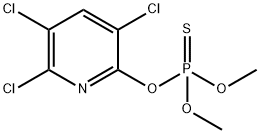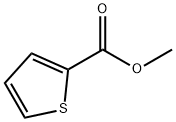Chlorpyrifos-methyl
- CAS NO.:5598-13-0
- Empirical Formula: C7H7Cl3NO3PS
- Molecular Weight: 322.53
- MDL number: MFCD00055310
- EINECS: 227-011-5
- SAFETY DATA SHEET (SDS)
- Update Date: 2024-12-18 14:15:30

What is Chlorpyrifos-methyl?
Description
Chlorpyrifos-methyl is a general use organophosphate insecticide registered in 1985. It is used for the control of stored grain pests, weevils, moths, borers, beetles and mealworms, red flour beetle, and grain moth; for seed treatment; and for warehouse. It is effective against rice stem borer, aphids, cutworms, plant and leaf hoppers, mole crickets and some moths, and stored grain pests. It is poorly soluble in water, moderately soluble in hexane and alcohols, and readily soluble in other organic solvents such as acetone, benzene, and chloroform.
Chemical properties
Chlorpyrifos-methyl is a general use organophosphate insecticide registered in 1985. It is used for the control of stored grain pests, weevils, moths, borers, beetles and mealworms, red fl our beetle, grain moth, for seed treatment. It is effective against rice stem borer, aphids, cutworms, plant and leaf hoppers, mole crickets, moths and stored grain pests. It is poorly soluble in water, moderately soluble in hexane and alcohols, and readily soluble in other organic solvents, such as acetone, benzene, and chloroform
Chemical properties
White or amber crystalline solid. May be dissolved in a flammable or combustible carrier solvent.
The Uses of Chlorpyrifos-methyl
Chlorpyriphos-methyl is an derivative of Chlorpyrifos (C425300), an insecticide that acts on the nervous system of insects by inhibiting acetylcholinesterase.
Definition
ChEBI: An organic thiophosphate that is O,O-dimethyl hydrogen phosphorothioate in which the hydrogen of the hydroxy group has been replaced by a 3,5,6-trichloropyridin-2-yl group.
General Description
Colorless crystals. Corrosive to copper, brass, iron, and tin plate. Used as an insecticide.
Air & Water Reactions
Hydrolyzed by strong acid and base.
Reactivity Profile
A chlorinated organophosphate derivative. Organophosphates are susceptible to formation of highly toxic and flammable phosphine gas in the presence of strong reducing agents such as hydrides. Partial oxidation by oxidizing agents may result in the release of toxic phosphorus oxides. Chlorpyrifos-methyl is incompatible with strong acids and bases.
Health Hazard
Exposures to chlorpyrifos-methyl cause excessive salivation, sweating, rhinorrhea and tearing, muscle twitching, blurred vision/dark vision, slurred speech, weakness, tremor, incoordination, headache, dizziness, nausea, vomiting, abdominal cramps, diarrhea, respiratory depression, tightness in chest, wheezing, productive cough, fl uid in lungs, and pin-point pupils. In cases of severe exposure and poisoning, chlorpyrifos-methyl causes seizures, incontinence, respiratory depression, loss of consciousness, respiratory paralysis, and death. Exposures to chlorpyrifos-methyl cause cholinesterase inhibition in workers, and the systemic toxicity includes body weight loss, decreased food consumption, and liver, kidney, and adrenal pathology
Agricultural Uses
Insecticide: Chlorpyrifos-methyl is used on stored grain (for protection of stored food, feed oil, and seed grains against injury from stored grain weevils, moths, borers, beetles and mealworms including granary weevil, rice weevil, red flour beetle, confused flour beetle, saw-toothed grain beetle, Indian meal moth, and Angoumois grain moth, lessor grain borers), seed treatment, grain bin and warehouse. [14] In 2000, the registrants of chlorpyrifos-methyl requested voluntary cancellation of their products rather than committing to develop additional data for reregistration
Trade name
DOWCO-217®; NOLTRAN®; RELDAN®; RELDANE® , STORCIDE®; ZERTELL®
Safety Profile
Moderately toxic by ingestion, intraperitoneal, and skin contact routes. A skin irritant. Experimental reproductive effects. When heated to decomposition it emits very toxic fumes of Cl-, NOx POx and SOxA pesticide.
Potential Exposure
Chlorpyrifos-methyl is a general use organophosphate insecticide for use on stored grain (for protection of stored food, feed oil, and seed grains against injury from stored grain weevils, moths, borers, beetles, and mealworms including granary weevil, rice weevil, red flour beetle, confused flour beetle, saw-toothed grain beetle, Indian meal moth, and Angoumois grain moth, lessor grain borers), seed treatment, grain bin, and warehouse.
Shipping
UN2783 Organophosphorus pesticides, solid, toxic, Hazard Class: 6.1; Labels: 6.1-Poisonous materials. UN3018 Organophosphorus pesticides, liquid, toxic, Hazard Class: 6.1; Labels: 6.1-Poisonous materials.
Incompatibilities
Strong oxidizers, strong acids, and alkalies. In the presence of strong reducing agents such as hydrides, organophosphates form highly toxic and flammable phosphine gas. Contact with oxidizers can cause the release of toxic oxides of phosphorus. Corrosive to copper, brass, iron, and tin plate.
Waste Disposal
This compound is 50% hydrolyzed in aqueous methanol solution @ pH 6 in 1930 days; and in 7.2 days at pH 9.96. Spray mixtures of <1% concentration are destroyed with an excess of 5.25% sodium hypochlorite in ,30 minutes @ 100°C; and in 24 hours @ 30°C. Concentrated (61.5%) mixtures are essentially destroyed by treatment with 100:1 volumes of the above sodium hypochlorite solution and steam in 10 minutes. Containers must be disposed of properly by following package label directions or by contacting your local or federal environmental control agency, or by contacting your regional EPA office
Precautions
Workplaces should have adequate washing facilities at all times during handling and these should be close to the site of handling. Eating, drinking, and smoking should be prohibited during handling and before washing after handling. Containers of chlorpyrifosmethyl should be kept away from foodstuffs, animal feed and their containers, and out of reach of children
Properties of Chlorpyrifos-methyl
| Melting point: | 45.5-46.5°C |
| Boiling point: | 347.3±52.0 °C(Predicted) |
| Density | 1.64 g/cm3(Temp: 23 °C) |
| Flash point: | >100 °C |
| storage temp. | APPROX 4°C
|
| solubility | Chloroform: Slightly Soluble |
| form | Crystalline Solid |
| pka | -5.59±0.10(Predicted) |
| color | Amber |
| Water Solubility | 4mg/L(25 ºC) |
| Merck | 13,2208 |
| BRN | 1541078 |
| CAS DataBase Reference | 5598-13-0(CAS DataBase Reference) |
| NIST Chemistry Reference | o,o-Dimethyl-o-(3,5,6-trichloro-2-pyridyl)phosphorothioate(5598-13-0) |
| EPA Substance Registry System | Chlorpyrifos-methyl (5598-13-0) |
Safety information for Chlorpyrifos-methyl
| Signal word | Danger |
| Pictogram(s) |
 Skull and Crossbones Acute Toxicity GHS06  Environment GHS09 |
| GHS Hazard Statements |
H302:Acute toxicity,oral H317:Sensitisation, Skin H331:Acute toxicity,inhalation H410:Hazardous to the aquatic environment, long-term hazard |
| Precautionary Statement Codes |
P261:Avoid breathing dust/fume/gas/mist/vapours/spray. P273:Avoid release to the environment. P280:Wear protective gloves/protective clothing/eye protection/face protection. P301+P312:IF SWALLOWED: call a POISON CENTER or doctor/physician IF you feel unwell. P302+P352:IF ON SKIN: wash with plenty of soap and water. |
Computed Descriptors for Chlorpyrifos-methyl
Chlorpyrifos-methyl manufacturer
Bhagiradha Chemicals And Industries Limited
Aimco Pesticides Limited
New Products
Tert-butyl bis(2-chloroethyl)carbamate 4-Methylphenylacetic acid N-Boc-D-alaninol N-BOC-D/L-ALANINOL N-octanoyl benzotriazole 3-Morpholino-1-(4-nitrophenyl)-5,6-dihydropyridin- 2(1H)-one Furan-2,5-Dicarboxylic Acid DIETHYL AMINOMALONATE HYDROCHLORIDE 1,1’-CARBONYLDIIMIDAZOLE R-2-BENZYLOXY PROPIONIC ACID 1,1’-CARBONYLDI (1,2-4 TRIAZOLE) N-METHYL INDAZOLE-3-CARBOXYLIC ACID (2-Hydroxyphenyl)acetonitrile 4-Bromopyrazole 5-BROMO-2CYANO PYRIDINE 5,6-Dimethoxyindanone 5-broMo-2-chloro-N-cyclopentylpyriMidin-4-aMine 2-(Cyanocyclohexyl)acetic acid 4-methoxy-3,5-dinitropyridine 1-(4-(aminomethyl)benzyl)urea hydrochloride 2-aminopropyl benzoate hydrochloride diethyl 2-(2-((tertbutoxycarbonyl)amino) ethyl)malonate tert-butyl 4- (ureidomethyl)benzylcarbamate Ethyl-2-chloro((4-methoxyphenyl)hydrazono)acetateRelated products of tetrahydrofuran








You may like
-
 5598-13-0 Chlorpyrifos-methyl 98%View Details
5598-13-0 Chlorpyrifos-methyl 98%View Details
5598-13-0 -
 5598-13-0 Chlorpyrifos-methyl 98%View Details
5598-13-0 Chlorpyrifos-methyl 98%View Details
5598-13-0 -
 Chlorpyrifos-Methyl Technical 97%Min CAS 5598-13-0View Details
Chlorpyrifos-Methyl Technical 97%Min CAS 5598-13-0View Details
5598-13-0 -
 Chlorpyrifos-methyl CAS 5598-13-0View Details
Chlorpyrifos-methyl CAS 5598-13-0View Details
5598-13-0 -
 Chlorpyrifos-methyl CAS 5598-13-0View Details
Chlorpyrifos-methyl CAS 5598-13-0View Details
5598-13-0 -
 14714-50-2 (2-Hydroxyphenyl)acetonitrile 98+View Details
14714-50-2 (2-Hydroxyphenyl)acetonitrile 98+View Details
14714-50-2 -
 118753-70-1 98+View Details
118753-70-1 98+View Details
118753-70-1 -
 733039-20-8 5-broMo-2-chloro-N-cyclopentylpyriMidin-4-aMine 98+View Details
733039-20-8 5-broMo-2-chloro-N-cyclopentylpyriMidin-4-aMine 98+View Details
733039-20-8